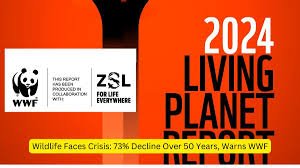Wildlife Faces Crisis: 73% Decline Over 50 Years, Warns WWF
Introduction to the Crisis
The World Wildlife Fund (WWF) has issued a stark warning about the ongoing crisis in wildlife populations globally. According to the latest findings, there has been a staggering 73% decline in wildlife populations since 1970. This report highlights the critical state of biodiversity, emphasizing the urgent need for conservation efforts and policy reforms to address this alarming trend. As human activities continue to encroach upon natural habitats, the repercussions for various species are dire.
Key Factors Contributing to Decline
Several factors have contributed to this decline in wildlife populations. Habitat loss, driven by urbanization, agriculture, and logging, has significantly reduced the available space for numerous species. Additionally, pollution, climate change, and overexploitation of resources have further exacerbated the situation. The WWF’s report calls attention to the interconnectedness of these factors, illustrating how human actions have disrupted ecosystems, leading to the decline of vital species that play essential roles in their habitats.
Urgent Need for Conservation Efforts
The WWF emphasizes that immediate action is necessary to reverse this trend. Effective conservation strategies must focus on protecting natural habitats, implementing sustainable practices, and enforcing laws to curb illegal wildlife trade. The report also stresses the importance of global collaboration among governments, NGOs, and local communities to foster biodiversity. This collaborative approach will be vital in ensuring the survival of endangered species and restoring ecological balance.
Public Awareness and Action
Raising public awareness about wildlife conservation is crucial. The WWF encourages individuals to take action by supporting conservation organizations, advocating for sustainable practices, and educating others about the importance of biodiversity. By fostering a collective responsibility toward wildlife preservation, society can work together to create a future where both humans and wildlife can thrive.

Why This News is Important
Significance for Biodiversity
The alarming decline of 73% in wildlife populations over the last 50 years highlights a critical issue for biodiversity. Healthy ecosystems depend on a variety of species, and their loss can disrupt ecological balance, leading to further declines in plant and animal populations. Understanding the significance of biodiversity is essential for students, especially those preparing for government exams in fields related to environmental science, biology, and policy-making.
Impact on Human Life
The decline of wildlife populations poses direct and indirect threats to human life. Healthy ecosystems provide essential services such as clean air, water, and food. A decline in biodiversity can result in the loss of these services, leading to significant challenges in areas like agriculture and public health. This news serves as a reminder of the interconnectedness between wildlife and human existence, underscoring the need for sustainable practices in policy-making.
Role of Government and Policy
For students aspiring to work in government roles, this news emphasizes the importance of environmental policy and conservation efforts. Understanding the causes and implications of wildlife decline will be crucial for future policymakers. The report serves as a call to action for governments worldwide to prioritize biodiversity in their agendas, develop effective legislation, and allocate resources toward conservation efforts.
Historical Context
The decline of wildlife populations is not a new phenomenon. Historical events, such as the Industrial Revolution, marked a significant turning point in human impact on the environment. Rapid industrialization led to habitat destruction and increased pollution, setting the stage for biodiversity loss. Over the decades, initiatives like the Endangered Species Act (1973) and various international agreements have aimed to protect wildlife; however, challenges persist. The ongoing climate crisis has further strained these efforts, highlighting the urgent need for renewed commitment and innovative solutions to safeguard biodiversity for future generations.
Key Takeaways from “Wildlife Faces Crisis: 73% Decline Over 50 Years”
| Serial No. | Key Takeaway |
|---|---|
| 1 | WWF reports a 73% decline in global wildlife populations since 1970. |
| 2 | Major factors contributing to this decline include habitat loss, pollution, and climate change. |
| 3 | Immediate conservation efforts are needed to protect natural habitats and biodiversity. |
| 4 | Public awareness and action are crucial for wildlife conservation. |
| 5 | Understanding wildlife decline is vital for future policymakers and environmental advocates. |
Important FAQs for Students from this News
What does the WWF report indicate about wildlife populations?
The WWF report indicates a 73% decline in wildlife populations globally since 1970, emphasizing the urgent need for conservation efforts.
What are the main factors contributing to wildlife decline?
Key factors include habitat loss due to urbanization and agriculture, pollution, climate change, and overexploitation of resources.
Why is biodiversity important for ecosystems?
Biodiversity is crucial for maintaining ecological balance, providing essential services such as clean air, water, and food, and supporting overall ecosystem health.
What actions can individuals take to support wildlife conservation?
Individuals can support conservation organizations, advocate for sustainable practices, and educate others about the importance of biodiversity.
How does wildlife decline impact human life?
The decline of wildlife can lead to loss of ecosystem services that are vital for human health and well-being, affecting food security, clean water availability, and air quality.
Some Important Current Affairs Links













